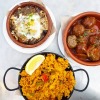Isn’t it strange that sometimes those who are the most passionate and knowledgeable about a particular country or region’s food are not actually from that culture themselves?
So it is with Regula Ysewijn. Born and raised in Flanders (the Dutch speaking part of Belgium), she is a professional graphic designer, photographer and writer as well as a self-taught cook and a successful food blogger. Regula has been obsessed with Britain since she was a young child, after hearing a British nursery rhyme which caught her imagination. A few years later – her infatuation showing no signs of abating – her parents arranged a family holiday to Britain for her ninth birthday; she describes it as ‘to this day still the best gift my parents ever gave me’.
She began to read extensively about British history and culture, and her family spent many more holidays in Britain over the next few years. During a period when further travel wasn’t possible, Regula so missed the British food she’d come to love that she decided to make it herself. With no cookery books to hand, she came across Jamie’s Naked Chef series on TV, and by watching him cook and making notes, she learned to cook. She still cooks that way today, ‘on pure fingerspitzengefühl’; literally ‘fingertips feeling’, figuratively it means by instinct or intuition.
Her blog Miss Food Wise was initially intended as a personal database of where she went, what she saw, what she was reading and of course, what she cooked. Naturally, with her interest in British food and culture, this soon came to feature heavily. She explains that people often asked her ‘why [she] was so fond of Britain since the food was so crap. [She] decided it was [her] mission to show it wasn’t and to dedicate the blog to it.’
Her blog soon won a loyal following of readers all around the world. It also became a learning curve for her writing and photography – indeed the design agency for whom she worked made her their in-house photographer on the back of her blog photography – and work from many agencies and magazines followed. When she was offered her book deal in 2013, Regula made the decision to leave her job to go freelance.
Pride and Pudding: The History of British Puddings is not a cookbook. Regula describes it as ‘a book about a part of British food culture/ history with recipes. The recipes are all historical, and many are not to modern taste, but that doesn’t make them less important.’
From the start, her publisher Murdoch Books was completely on board with Regula’s vision. I ask her about the process and she happily recalls how they told her ‘the book has to be “you” so only you can create that 100%’ for which she is hugely grateful. They gave her free rein on what the book would be. More unusually but perfectly logical given her unique skillset, Regula not only wrote the book but designed it and did all the food styling and photography herself too.
As well as Regula’s distinctive food photography, Pride and Pudding features gorgeous hand-drawn illustrations (on the cover and to introduce each chapter). These were created by Regula’s husband, Bruno Vergauwen; ‘He knew my vision and spent months creating the illustrations that tell part of the story. He had to understand the history of pudding to be able to create these images. He had to see the antique equipment and evolution in how pudding was made, he had to see the dishes to give him inspiration. I’m really in awe about what he has created.’
She may be in awe of Bruno’s illustrations (and they are very beautiful) but I am in awe of the book in its entirety. This rigorously researched culinary history of sweet and savoury puddings is a fascinating insight into many of the dishes we still eat today and how they evolved. I don’t use the word ‘rigorous’ lightly – I asked Regula how she approached such in-depth academic research.
To accurately understand the evolution of each pudding, Regula referenced her own collection of old books, accessed content from many specialist and online libraries and for rarer titles, contacted directly the great houses where she knew an original copy was available.
‘I didn’t take anything for granted, if a translation of Latin or Anglo Norman was given, I would check if the translation was correct. For Latin translations I had someone who could read the original as translations in the 17th century were often wrong. I tried to use as many primary sources as I could and when a more recent book mentioned a source, I would not copy that entry but look for that source and check it myself. There are mistakes which have been around for decades because authors sometimes don’t go back to check the source the book is mentioning.’
Her collection of vintage cookware also played its part, giving her an insight into the methods of cooking and the vessels and equipment used. She also mentions how the characteristics of some the ingredients themselves have changed over time.
There were many challenges in recreating historical recipes using the equipment available in a modern kitchen, but without changing the nature of the recipe itself. But when her countless rounds of testing resulted in success, ‘it filled [her] heart with joy to see it.’
‘To see how a medieval blancmange looked like and tasted, how black pudding tasted in the 16th century. That’s just so bloody amazing. A taste of history.’
The book is divided into chapters for Boiled and steamed Puddings; Baked puddings; Batter puddings; Bread puddings; Milk puddings, jellies and ices and Sauces, pastry etc.
These chapters are proceeded with a comprehensive and fascinating 20 page history of food in Britain, starting in prehistoric times and walking us through to modern times via the eras of the Romans, Saxons, Vikings and Normans, the Medieval centuries, the Reformation and on to Elizabethan, Georgian and Victorian times before bringing us into the 20th and 21st centuries.
Each chapter tells its story by way of several carefully chosen puddings, some of which will be familiar to readers and some of which have virtually been lost in the mists of time. Flipping through the book, I recognise plum pudding, haggis, black and white blood puddings, jam roly poly, spotted dick, treacle sponge, bakewell pudding, toad-in-the-hole, apple charlotte, blancmange, trifle, fruit fools and posset. But I’d never before come across rice pudding in skins (rather like sausages), sambocada (a cheese curd tart flavoured with elderflowers), daryols (custard tarts in deep hand-raised pastry cups), tort de moy (a bone marrow egg tart), black caps (apples baked until the skin on top turned black) or almond flummery (an almond and apricot-kernel flavoured jelly).
Food history books can sometimes be dry and academic but Regula has a delightful way of writing that brings the culinary stories of each of these puddings to life without unnecessary stuffiness.
It’s a fascinating book and certainly the most beautifully written and produced book of its genre that I’ve ever seen.
Recipe from Pride and Pudding
If you decide to buy this book after reading our content, please consider clicking through our affiliate link, located within the post and in the footnote at the end.
Kavey Eats received a review copy of this title from publisher Murdoch Books. Pride and Pudding: The History of British Puddings by Regula Ysewijn is currently available from Amazon for £16.59 (RRP £20).








Please leave a comment - I love hearing from you!20 Comments to "Pride and Pudding by Regula Ysewijn"
This has gone straight on to my Amazon wishlist, I love unusual and historical recipe books, and being a book about British food seen from the viewpoint of a non British person it sounds fascinating. Definitely one to add to my collection
Jane
Sounds as though it’s one you’ll really love, Jane and I think it will become a classic food history title too.
I hope you will enjoy it Jane, thank you!
Looks like a fantastic book. Love the artwork!
Yes, it’s very attractive and distinctive too.
Thank you Michelle!
This is a beautiful book and I too am in awe!
High five for our “great minds…”!
What an amazing story behind a truly original book! Don’t you think the illustration you featured looks a lot like the work of Mucha? Shame on Regula’s friends for saying our British food is crap!
A lovely and thorough review, Kavey. Thank you very much!
Yes, I totally know what you mean about that Mucha-esque quality. So beautiful! To be fair, back in the seventies and even into the eighties, there was a hell of a lot of really crap food in Britain, especially in restaurants (as opposed to peoples’ homes) and since visitors to UK would mostly eat in restaurants, it’s not surprising their impressions were poor!
Hello Snighha! Glad you like the illustration, my husband is definitely inspired by the work of Mucha, so was his father. I’m sorry if it sounded offensive that my friends think British food isn’t very nice. But I have also been giving lectures all over Belgium and most people in the audience have told me they think British food is not very nice. I have been laughed at by Germans, Dutch and French, when I tell them I write about British food all because of the reputation it has. Even British people have asked me why I bother. It is a general idea I’m afraid and one I have tried to change ever since I started to write and blog about British food over 5 years ago. When my book came out in Belgium it was greeted in the press with, British food is more than fish and chips with vinegar (vinegar on chips is alien to us) and greasy English Breakfast. It is ignorance I’m afraid. They don’t know what beautiful food you have in the UK because they haven’t been to the right places to eat. Plus there aren’t many books about British food available outside of Britain. So how would they know.
I agree thorough review and I am so very pleased! 🙂
Unfortunately British food did suffer for decades after WW2 and that lasted longer in restaurants than in homes, so visitors really wouldn’t have found the best of British food easily. Things have recovered dramatically but the reputation lags behind!
Wow, that looks amazing.
I love a good pudding. It’s a vastly underrated part of our cuisine.
Yes so underrated!
It’s a gorgeous book. I’ve really enjoyed it.
I think everyone I’ve spoken to who has a copy is really impressed by it!
Although I am not a pudding person, I am a food history person (not a buff, just a dabbler really). Based on what I am reading here Pride & Pudding sounds like it will turn out to be a classic of its own: a reference book for cooks and food historians in years to come. I know Regula’s work and have long been an admirer for just the reasons that you give. The rigorous attention to detail, the beautiful images and graphics, her enthusiasm for her all things British (when it hasn’t been fashionable to admit this). A great review of a classic in the making.
Thanks Kellie, yes to all your points. It’s an amazing book.
A beautifully written review, which Regula’s book deserves. I continue to be in awe of Regula’s commitment to this project from beginning to end and the dedication she has given every single detail in between.
Totally agree, such a very impressive result from such an immense undertaking!